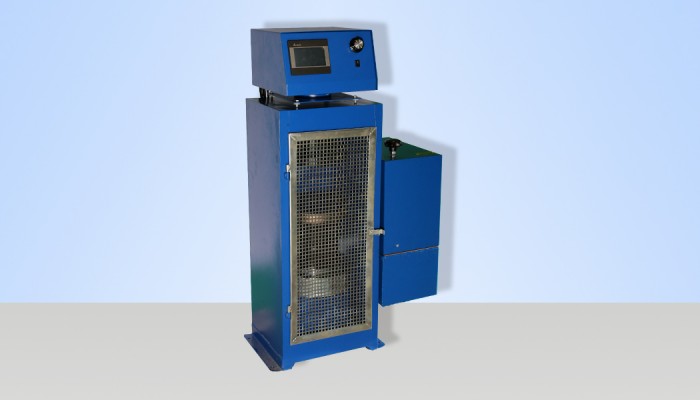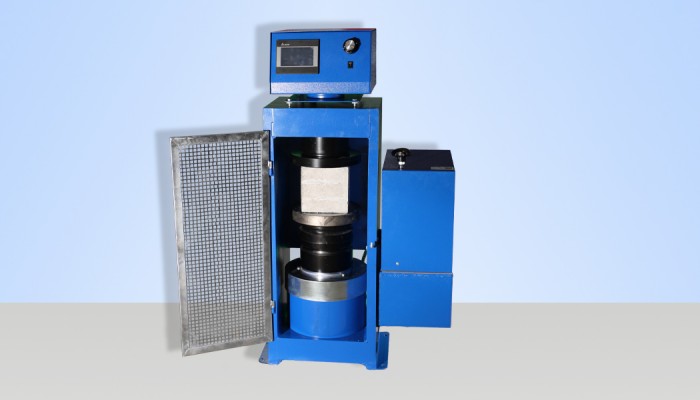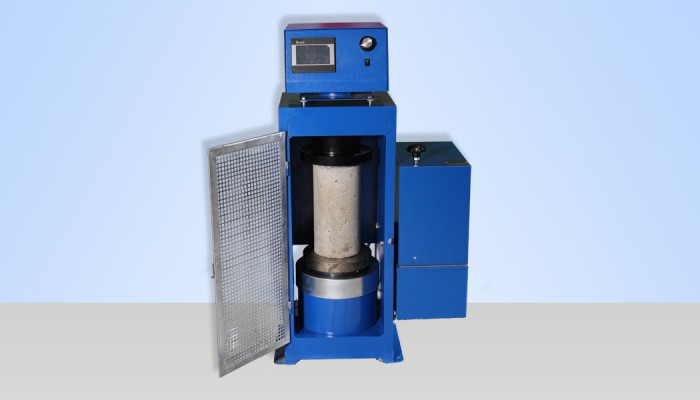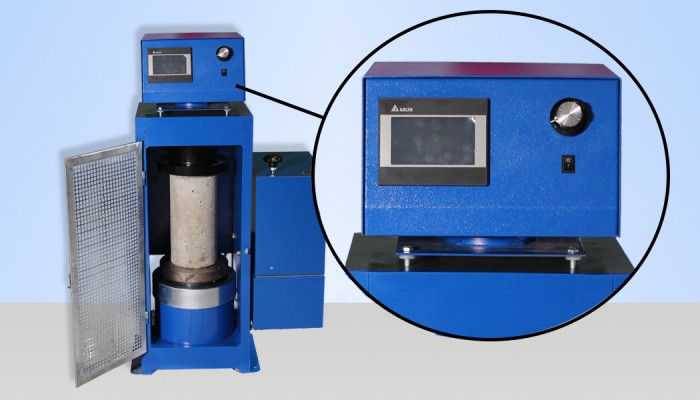200 Ton Compression Machines
One of the most effective and widely used in quality control testing of hardened concrete is the tests to determine the compressive strength of concrete. Concrete compressive strength is the test result which determines the compressive strength of concrete, this test is taken on the standard cubic or cylindrical samples, the most common test is a test about the quality of the concrete, take place in terms of resistance. In this test, three cubic sample with specific dimensions which should be equivalent at the end of the cylindrical sample. This test conducted by the pressure testing machine (press) that provides uniform load to the sample, This takes place by two heavy jaws and base work of the device in such a way extend the pressure that much needs to breaks down the sample and gives us maximum force.
To measure the compressive strength of concrete and samples are kept in the laboratory in a specific life, compressive strength test ASTM method on cylindrical samples of Ø150 × 300 mm (Ø6×12 inches) and in the BS method on cubic samples of 150 mm (6 inches), however in according to biggest size of aggregate, standards and the use of smaller and larger sample also permit. Compression Machines are so popular to be used to determine the compressive strength of concrete. Soil Mechanic Industries of Iran Co. succeeded to design and build Compression Machines which are fully automatic. One of the most important features of this Machines possible to control the uploading speed (closed-loop control) possibility of testing in automatically and manually mode, can be mentioned to the possibility of testing for strain and stress control.
|
Standards:
|
ASTM C39, EN 12390-4, AASHTO T22
|
Technical Specifications:
|
Description |
200 Ton Model CCM200 |
200 Ton Model CCM201 |
200 Ton Model CCM202 |
200 Ton Model CCM203 |
200 Ton Model CCM204 |
|---|---|---|---|---|---|
|
Ordering Code |
SMCO-3200 |
SMCO-3201 |
SMCO-3202 |
SMCO-3203 |
SMCO-3204 |
|
Dimentions L×W×H |
62×40×117 Cm |
62×40×107 Cm |
62×40×107 Cm |
62×40×107 Cm |
43×40×86 Cm
41×41×87 Cm
|
|
Weight Approx. |
450 Kg |
||||
|
Dimension of testing sample |
10×10×10 Cm, 15×15×15 Cm, 20×20×20 Cm, Ø10×20 Cm, Ø6×12 Inch |
||||
|
Nominal capacity |
200 Ton |
200 Ton |
200 Ton |
200 Ton |
200 Ton |
|
The maximum reading fault |
1% |
1% |
1% |
1% |
|
|
Power separation |
1 Ton |
200 Kgf |
200 Kgf |
100 Kgf |
100 Kgf |
|
Determine the speed of loading |
Manual |
Manual |
Manual |
Automatic |
Automatic |
|
Loading speed range |
50 to 2000 Kg/sec | ||||
|
Load speed limit is a function of samples hardness. Minimum load speed increased with increasing hardness. By reducing the hardness the maximum load speed reduced |
|||||
|
Display the speed |
NA |
AV |
AV |
AV |
AV |
|
Display MOMENT SPEED |
NA |
AV |
AV |
AV |
AV |
|
Display type |
Gauge |
3” Touch screen |
3” Touch screen |
3” Touch screen |
7” Touch screen |
|
Memory storage of test results |
NA |
100 Tests |
100 Tests |
2000 Tests |
2000 Tests |
|
PC connectivity and transfer results to a PC |
NA |
AV |
AV |
AV |
AV |
|
Ability to perform tests as controlled movement |
NA |
NA |
NA |
AV |
AV |
|
Ability to plot the displacement force curve and determine the modulus of elasticity and Poisson coefficient. |
NA |
NA |
AV |
NA |
AV |
|
Body model |
Wall |
Wall |
Wall |
Wall |
Wall |
|
The maximum distance between two jaws |
32 Cm |
||||
|
Height spacers plates |
65 mm, 100 mm |
||||
Notes:
- It should be noted in order to maintain and long-term performance of compression machine, it is recommended the force applied to the device does not exceed 80% of Nominal Capacity.
- Soil Mechanic Industries of Iran (SMI) provides a possibility for owners of the old analog or digital compression machine of The (SMI) Company or the other foreign products to reduce the costs of upgrading the compression machine.
-
The concrete strength is influenced by two factors:
-
Time
-
Temperature
-
With the progress of cement hydration, increases the concrete strength. Cement hydration process also increases with passing time as well as rising temperature. As a result, concrete strength can be expressed as a function of time and temperature combination. To stabilize the effect of temperature on concrete strength all samples are kept at a constant temperature. The strength of concrete will be determined usually in a timeframe of 3, 7, 28 days. Basis of The concrete acceptance, testing resistance at 28 days timeframe and at a constant temperature, resistance in another timeframe (eg, 7 days) used only to obtain an estimate of the 28-day strength it cannot be the basis to accept or reject the concrete 7-day resistance is approximately 70% to 80% of 28-day strength.








